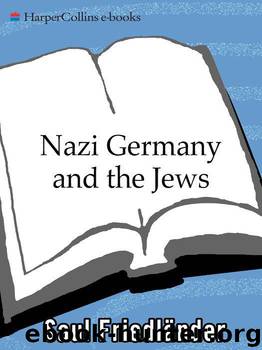Nazi Germany and the Jews, Volume 01: The Years of Persecution by Saul Friedlander

Author:Saul Friedlander
Language: eng
Format: mobi, epub
Tags: European History
Publisher: HarperCollins e-books
Published: 2008-12-01T15:00:00+00:00
In Stuttgart the exclusion of Jews from public swimming pools was postponed until after the Olympic Games; anti-Jewish initiatives did not, however, lag behind those in other German cities. Quite the contrary. The local party leaders were infuriated by the fact that, at least until 1937, the Jewish population of the city was growing rather than declining. Jews from the small towns and villages of surrounding Württemberg were fleeing to the city in the hope of finding both the protection of anonymity and the support of a larger community. Thus, whereas during the first seven months of 1936, 582 Jews left Stuttgart, 592 moved in. It was only at the end of 1937 that the four-thousand-strong Jewish population started to decline.69
The city council decided to take Jewish matters in hand. After asking for advice from, of all places, Streicher’s Nuremberg, the council decided at its September 21, 1936, meeting that old people’s homes, nursery schools, and (finally) swimming pools belonging to the city were forbidden to Jews; in hospitals Jews were to be separated from other patients; city employees were forbidden to patronize Jewish shops and consult Jewish physicians; Jewish businessmen were forbidden to attend markets and fairs; and the city canceled all its own real estate and other business transactions with Jews.70
Paradoxically these initiatives led to a clash with the state administration of Württemberg, when the latter demanded that a Stuttgart Jewish developer be exempted from the building limitations. The city council complained to the Württemberg Ministry of the Interior, and Stuttgart mayor Karl Strölin mentioned the incident as an example of the differences that could arise between city and state authorities regarding the implementation of anti-Jewish policies.71
Such confrontations, mainly between regional bureaucracies and local party members, were actually not unusual. In Offenburg, in Baden, one started on March 19, 1937, with a complaint sent by a Jewish attorney, Hugo Schleicher, to the Offenburg district office in the name of the local Jewish community and of the Jews of Gengenbach, an Offenburg suburb. A grocer there, a certain Engesser, had refused to sell groceries and milk to a Jewish customer named Ferdinand Blum. The reason, it soon appeared, was that the mayor of Gengenbach, who also chaired the finance committee of the local hospital, had informed Engesser that he would not be allowed to sell his wares to the hospital if he continued to sell goods to Jews. As all grocers in Gengenbach were allowed to sell to the hospital, the mayor’s tactics would quickly achieve a result that Schleicher clearly defined in his letter: “The final consequence of this measure will be that the Jewish population of Gengenbach will no longer be provided with food and milk.”72
The Offenburg district office forwarded the complaint to Gengenbach’s mayor and asked for an answer. On April 2 the mayor wrote back “concerning the complaint of the Jew H. Schleicher”: “The facts presented in the complaint are correct. At the crow-black Engesser’s [“crow-black” meant that Engesser was a devout Catholic], the customers,
Download
Nazi Germany and the Jews, Volume 01: The Years of Persecution by Saul Friedlander.epub
This site does not store any files on its server. We only index and link to content provided by other sites. Please contact the content providers to delete copyright contents if any and email us, we'll remove relevant links or contents immediately.
| African-American Studies | Asian American Studies |
| Disabled | Ethnic Studies |
| Hispanic American Studies | LGBT |
| Minority Studies | Native American Studies |
Cecilia; Or, Memoirs of an Heiress — Volume 1 by Fanny Burney(31348)
Cecilia; Or, Memoirs of an Heiress — Volume 3 by Fanny Burney(30946)
Cecilia; Or, Memoirs of an Heiress — Volume 2 by Fanny Burney(30905)
The Great Music City by Andrea Baker(21503)
We're Going to Need More Wine by Gabrielle Union(18081)
Bombshells: Glamour Girls of a Lifetime by Sullivan Steve(13117)
Pimp by Iceberg Slim(12940)
All the Missing Girls by Megan Miranda(12769)
Fifty Shades Freed by E L James(12461)
Talking to Strangers by Malcolm Gladwell(11901)
Norse Mythology by Gaiman Neil(11895)
Crazy Rich Asians by Kevin Kwan(8367)
Mindhunter: Inside the FBI's Elite Serial Crime Unit by John E. Douglas & Mark Olshaker(7845)
The Lost Art of Listening by Michael P. Nichols(6481)
Enlightenment Now: The Case for Reason, Science, Humanism, and Progress by Steven Pinker(6412)
Bad Blood by John Carreyrou(5778)
The Four Agreements by Don Miguel Ruiz(5527)
Weapons of Math Destruction by Cathy O'Neil(5045)
We Need to Talk by Celeste Headlee(4879)
